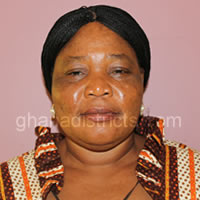TRANSPORTATION SYSTEMS
Road Infrastructure
The principal mode of transportation in the District is by road. An important aspect of spatial organization in terms of settlement is the distribution of services, which depends on the road network. The District’s road network consists of highways, urban roads and feeder roads.
The District has a total road length of 927.69 kilometres, of these the feeder road network consists of 454.40 (49%) kilometres with 473.29 kilometres. Of the feeder roads 207.7 kilometres (65.7%) is engineered with 108.0 kilometres (34%) partially engineered. 38.62% of the roads in the district are in good condition, 38.14% fair and 36.96 in poor condition.
Accessibility in terms of feeder roads is not satisfactory. Most of the feeder roads are not rehabilitated regularly. The degradation rate is also very high due to heavy rainfall and heavy-duty trucks that ply them. Some feeder roads become almost impassable during the rainy season, placing farmers at the mercy of exploitative transporters and middlemen. Table 1.15: shows the surface and condition types of feeder roads in the District. Of the 473.29km, 116.28km representing 24.21% is paved and 364.01km representing 75.79% is unpaved as at 2009.
TELECOMMUNICATION FACILITIES
Telephone Facilities and ICT
Six mobile phone services, Vodafone, MTN, Tigo, Airtel, Glo and Espresso are available in almost all of the major settlements. There are no landlines connected. Generally, telecommunication facilities are poorly distributed in the District. Telecommunication facilities are not easily accessible to many localities in the District. The advent of cell phone has however made communication easy except in remote areas with limited coverage. According to the 2010 PHC, about 46 percent of the population aged 12 years and older own mobile phones. Also, males are more likely to own a mobile phone (51.9%) than females (40.5%).
Similarly, the 2010 PHC revealed that about two percent of the population aged 12 years and older use internet in the District with a higher percentage of males (3.4%) compared to females (1.4%). Close to four percent of households own desktop/laptop computers in the District. There is therefore the need to expand telecommunication infrastructure, including internet connectivity.
Housing
Good housing is one of the basic requirements of man. An important parameter for measuring welfare in a locality is therefore, the housing condition.
According to the 2010 PHC, out of a total household population of 24, 076,327 in the country, 2,265,458 are in the region and 58,701are in the District. There are a total of 331,967 houses recorded during the 2010 PHC in the region, of which a total number of 8,391 in the district. With a total household population, the proportion of urban is 48.5 percent, while computation for rural constitute 51.5 percent. The proportion of houses in the rural locality (54.3%) is more than those in the urban locality (45.7%).
The population per house in the urban locality which is 7.5 percent is higher than the rural localities (6.7). Average household per house in the urban locality (1.7) is slightly higher than the rural locality (1.5). This could be as a result of urbanization and rural-urban migration for the purpose of education, business and work. The average household size in the rural areas was more (4.4) than the urban average household size (4.3).
This calls for an increase in the housing stock with the growth commercial activities and locations of number of organization and businesses in the District to address the needs of public/private institutions.
House Ownership Status
Under this topic we discuss the ownership status of dwelling units by sex of household head and type of locality in the Techiman North District. According to the 2010 PHC the proportion of houses owned by household members was more than half (54.2%) of the total number of dwelling units in the District. The proportion of dwelling houses owned by a relative not a household member was about one-fifth (17.8%) comprising 15.4 percent males and 22.1 percent females. This indicates more females than males in the district own houses which they have given out to relatives to occupy.
However, with regards to dwelling houses owned by other private individuals in the district more males (26.2%) than females (22.8%). Also, a little more than one percent (1.2%) of dwelling houses are owned through mortgage with no variation among the two sexes. Ownership by other private agency is 37.8 percent while public/government ownership and other is less than one percent of the total population of households and among both the male and female populations.
In terms of locality, dwelling units owned by household members is higher in rural localities accounting for 55.4 percent whiles that of urban localities is 53.1 percent. In contrast, dwelling units owned by relative not a member of the household and other private individual is higher in the urban areas than in the rural areas.
Housing condition
The type of material used for constructing various parts of dwelling unit determines the durability and life span of the dwelling unit. The 2010 PHC revealed that the main material for outer wall of dwelling unit is cement block/concrete. More than half (56.8%) of dwelling units in the district have outer walls constructed with cement blocks or concrete while 35.3 percent of the dwelling units are constructed with mud bricks or earth. The use of cement blocks/concrete also features most prominently in wall construction in the urban localities (59.1%) while rural localities mostly use mud brick/earth (31.1%) of wall materials. Also, dwelling units with bamboo outer wall construction is uncommon in the district for which reason it recorded only 0.1percent apiece in the urban and rural localities.
Again, the 2010 PHC indicated that Cement or concrete (76.4%) and earth/mud (20.7%) are the two main construction materials used for floors in the district. Similarly, cement or concrete is the main construction materials for the floor of dwelling unit in the urban (80.1%) and rural (72.8%) localities.
Furthermore, the main construction material for roofing of dwelling unit is metal sheet representing (89.5%), followed by thatch/palm leaf or raffia (5.9%). The use of metal sheet for roofing in both urban and rural areas is 90.4 percent and 88.7 percent respectively.
Room Occupancy
The 2010 PHC collected information on type of occupied dwelling unit by sex of household head and type of locality. It also collected data on household size and number of sleeping rooms occupied in dwelling unit. The distribution of household size according to number of rooms occupied, the data revealed that a large proportion of all single member households (92.8%) occupy one room, while more than half of the households with two members (79.5%) and household with three members (70.2%) occupy one room. The percentage of seven (22.5%) and eight (17.0%) member households that occupy single rooms can be subjected to further research in the district to ascertain whether such a situation creates overcrowding in a single room.
Moreover, household size ten and above (21.4%) occupy dwelling unit with three or more rooms. A comparison of the average household size of 4.4 percent for the district gives the impression that there is congestion in rooms. The situation in the district may be attributed to the fact that 70.8 percent of households live in the urban areas where rent charges are high. Also, the peri-urban nature of the district and closeness to Techiman, a commercial centre, can partly be attributed for this situation.
Main Source of Lighting
The distribution of households in living quarters by type of lighting is useful in determining the extent of electricity coverage in the district for planning purposes. According to the 2010 PHC electricity and flashlight/Torch are the main sources of lighting for households in the district with kerosene lamp being the third most important source of lighting. There are more households in urban areas that use electricity as source of lighting than in rural areas. Also, among the rural localities electricity (65.4%) is the predominant source of lighting followed by flashlight/Torch (22.9%). On the other hand gas lamp, (0.1%), solar energy (0.1%), crop residue (0.1%) and other (0.1%) represent the least sources of lighting in the rural locality.
Main source of fuel for cooking
The main source of fuel for cooking is wood accounting for about half (49.1%) of the fuel source in the district. This follows a similar pattern with figures recorded for national and the region all indicating that wood fuel is the highest used in most households for cooking. Charcoal is the second most used cooking fuel representing 36.6 percent. The third most common source of cooking fuel for household is none no cooking constituting 7.3 percent. Gas as a source of fuel for cooking in the district is 5.7 percent. All other cooking fuel makeup one percent (1.0%).
The 2010 PHC also indicates that wood fuel is still the most preferred source of cooking fuel among urban and rural households. In urban areas, almost half (47.4%) of the households use wood as the main source of cooking fuel. Again, majority (50.7%) of the household in the rural areas use wood as cooking fuel. Charcoal is the second most preferred source of cooking fuel in urban localities representing 38.4 percent.
The rural household also has similar proportion which makes up 34.8 percent of the households that preferred charcoal as a source of cooking fuel. The consumption of Gas as a source of fuel for cooking constitutes 6.2 percent in the rural areas as compared to 5.2 percent in the urban areas. The least sources of cooking fuel for households in urban localities are electricity (0.1%) and animal residue (0.0%). This is similar to rural areas with electricity, kerosene at 0.1 percent apiece.
The large proportions of the urban and rural households that use wood and charcoal as the main source of cooking fuel will result to pressure on the existing forest which will lead to the destruction and degradation of the forest in the district.
Date Created : 11/21/2017 3:30:01 AM





